What is NPK fertilizer
The NPK compound fertilizer refers to a fertilizer variety that contains more than two elements in the three nutrient elements of nitrogen (N), phosphorus (P), and potassium (K) required by crops, or contains a variety of nutrient elements including medium or trace elements, and is mechanically mixed and manufactured. Products made from granulation, drying, screening, etc. According to its physical state, it can be divided into solid compound fertilizer and liquid compound fertilizer. Solid compound fertilizer is divided into powder, granulation (from dry granulation) and bulk blended compound fertilizer.
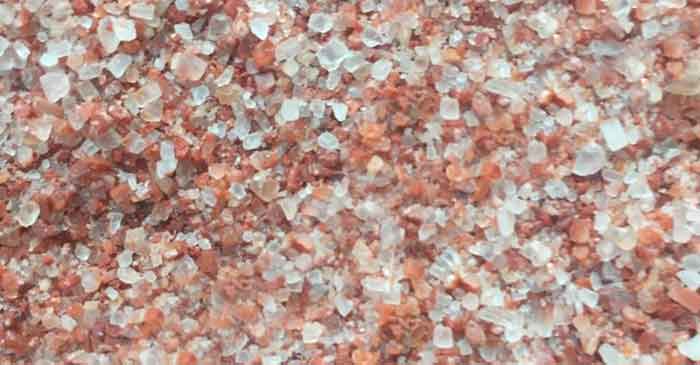
Advantages of granular NPK fertilizer
These granulated pellets are quite good in quality, and have features as follow:
- Sufficient strength,
- No agglomeration;
- Large enough particle size, with few or no dust;
- Good liquidity;
- Uniform particle size.
When using on the agricultural industry, we get these benefits:
- Complete nutrients
- High nutrient utilization
- Low environmental pollution
- Easy for mechanized fertilization and aerial fertilization
According to the chemical properties of the soil and the growth requirements of crops, different nutrient distribution ratios, different particle sizes or when using coating agents can improve the dissolution rate of nutrients in the soil, scientific fertilization, and fertilizer efficiency, thereby improving chemical fertilizers utilization rate, to obtain better agricultural production increase effect.
NPK compound fertilizer can improve the utilization rate of chemical fertilizers and crop yield, which is an inevitable trend of modern chemical fertilizer development.
How to make granular (pellet) fertilizer – 4 ways
Granular compound fertilizer is developed on the basis of powdered compound fertilizer. Granular compound fertilizer is a granular fertilizer that uses chemical or physical methods to process non-granular or powdered materials into the required size, and has a certain mechanical strength and stability. The production process has 4 types: agglomeration granulation, slurry coating granulation, melt coagulation granulation and compacting granulation.
The agglomeration granulation process is to moisturize and increase the temperature of the solid raw material to reach the liquid phase necessary for granulation, and then send it to the granulator (drum, disc) for agglomeration and granulation.
 disc pelletlizer
disc pelletlizerThe slurry coating granulation process is to spray the base fertilizer into the granulator in the form of slurry, apply it on the surface of the returned material particles, coat or powder into a ball, and then send it to dry, and then enter the granulator as the returned material The pelletizer is coated with the slurry again, and this is repeated so that the particles are repeatedly coated until they meet the size requirements.
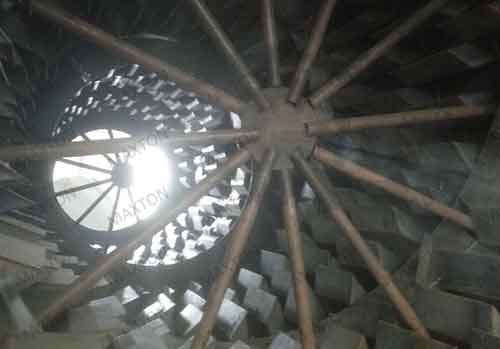 inside of drum pelletizer for slurry coating granulation
inside of drum pelletizer for slurry coating granulationThe melt granulation process is to heat the material and use the heat of the chemical reaction of the material to spray the material through the nozzle in the form of an anhydrous liquid. The liquid can be directly condensed into granules in the refrigerant, or it can be coated on the granulator condensed into granules on the particles.
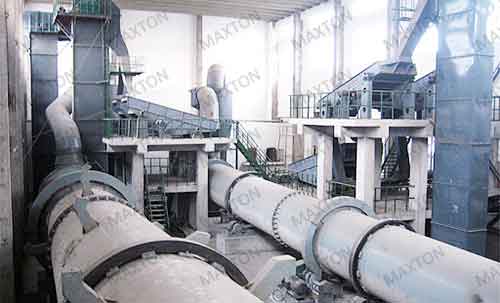 tower melt granulation system
tower melt granulation systemThe products of the above 3 kinds of granulation processes have high granule precision and good appearance quality, but chemical reactions and physical changes will occur during production, and the production process is complicated and corrosive.
In addition, the agglomeration granulation and slurry granulation processes can only produce mixed fertilizers. It will take 3 to 10 hours to change product specifications. The raw material requirements are limited. The amount of urea added is <7%, and the effective nutrient recovery rate is 96%. The production process medium material loss> 2%, high energy consumption, high processing cost, large amount of sewage, large environmental pollution, and high construction investment.
The compacting granulation process
The compacting granulation process is a dry granulation process that mixes powdered materials and relies on external pressure to agglomerate the materials. When the material is under high pressure, the particles get close to each other to cause molecular force, electrostatic force, and valence force, so that the molecules are tightly combined and reunited.
Advantage of the compacting granulation process
- The technology is mature and reliable, and the granulation equipment is advanced and complete, which can realize automatic control;
- The adaptability of the raw materials is strong, the urea addition amount is less than 25%, and the drying and cooling procedures are generally not required. It is especially suitable for heat-sensitive materials. Ammonium bicarbonate can be used as a base fertilizer;
- It is easy to change the product scale and add trace elements, and the time to change the product specification only needs 20 to 40 minutes;
- Adapt to various production scales, flexible production and operation;
- Low energy consumption, high compacting ratio, material loss less than 1%, and low production cost;
- There is no high temperature operation in the production process, low corrosiveness, low equipment cost, no sewage discharge, only a small amount of dust, and low environmental pollution;
- The concentration of compound fertilizer is high, organic fertilizer can be added as needed;
- The project investment is low. According to the research of the International Fertilizer Development Center, the investment of the compacting granulation method for the device with an annual output of 120,000 tons of granular compound fertilizer is 20% lower than that of the agglomeration granulation method. 50% of slurry coating granulation. Its construction period is short but economic benefits are good.
The only disadvantage of the compacting granulation process is that its product appearance is not quite good and roundness, but it does not affect its fertilizer efficiency.
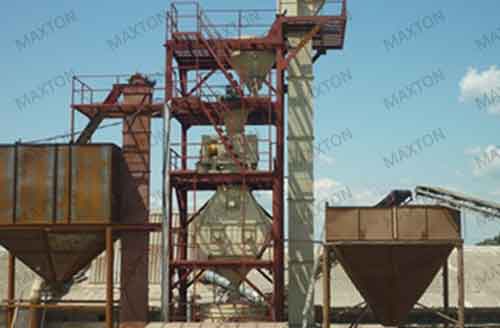
The process of compacting granulation
The compacting and granulation process is divided into four sections:
- Raw material preparation,
- Feeding and compacting,
- Granulation,
- Grain surface refining (if needed)
The various raw materials are crushed first, then automatic ingredients are weighed according to the requirements of the formula, after that send the mixture to the mixer for uniform mixing.
After being mixed and crushed by the crusher, the material is mixed and smashed into the humidifier for humidification, and then sent to the compactor to force the raw materials to be briquetted into flakes.
The flakes are crushed into granular materials by the granulator, and then sent to the screen machine. The small particles under the screen are returned and compacted again. The pellets on the screen are qualified. Qualified pellets are sent to the wet drum for grinding and spheronization (if needed), and then they are dried and hardened. The dried particles are sent to the vibrating screen, the powder under the sieve is returned to re-granulation, and the qualified particles on the sieve are sent to the cooler, and then sent to the coating film after cooling. Roll coating film wrap, you can get rounded granular compound fertilizer.
What will affect the quality of the granular (pellet)
Mainly there are 3 factors shall affect the quality of the granular
- Raw materials: including raw material characteristics, moisture, particle size distribution, plasticity, temperature and hardness.
- The operating conditions of the compacting: including the operating pressure, the diameter of the rolls and its circumferential linear speed (specific pressing force), the surface structure of the roller, the operating gap between the rollers, etc.;
- The different materials in the formula may undergo chemical reactions after extrusion granulation, and some may cause the particles to break. Therefore, after the raw materials and products are determined, it is better to take the compacting granulation evaluation test.
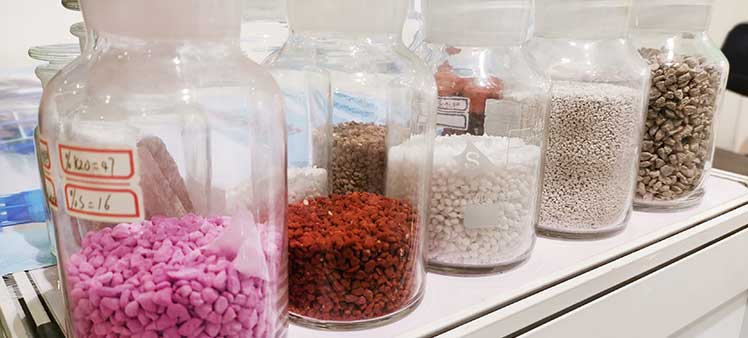
A typical application
A typical application of this type of system is a fertilizer system in Guatemala by compacting granulation. The factory chooses this place because the climate there is dry, which reduces moisture problems and provides high-quality calcium carbonate nearby.
The factory is designed as a combination of bulk mixing and compacting granulation. The production starts from the transportation of raw materials from the storage and sends these materials into the bulk mixing system. After bulk mixing, the raw materials are crushed into uniformly sized particles, mixed together with the backflow material and compacting on the compactors. The compactor compact a sheet with a thickness of about 10 mm. After crushing and screening, they get the final finished granular. All products are packaged and sold in polypropylene bags.
This factory has two production lines and runs continuously 24 hours a day. Their raw materials are granular urea, monoammonium phosphate, standard MOP (potash fertilizer), potassium magnesium (K-Mg) powder, boron powder and local calcium carbonate. The grades are 15-15-15, 16 20-0, 20- 20-0 and 18-6-12, particle size is 1,2~4 mm, used in coffee plantations.
It is worth mentioning that the water absorption of the powder after crushing has become a major problem. Urea is used as a raw material because it is the most economical nitrogen fertilizer resource, and it is an ideal binder. It enables the compactor to operate at low pressure, thus extending the service life of the equipment. However, due to its strong water absorption, part of the urea was later replaced by ammonium sulfate, reducing the urea content to 10-15%. The use of ammonium sulfate increased the production speed, modified the physical properties, and weakened the frictional resistance. In addition, it also added an important crop element-sulfur.
Monoammonium phosphate was used because it is a very economical P2O5 resource. MOP is used for potash fertilizer for the same reason. Potassium-magnesium powder and boronate 48 are also used in this factory to produce granular fertilizer. The filler calcium carbonate is produced near this factory and supplied in bulk form.
Regular chemical analysis is carried out to ensure the accuracy of each nutrient content in the formula. Although raw materials with different sizes of particles (large particles, general particles, powders) are used in the ingredients, for each ingredient, in order to obtain a uniform and accurate nutrient content, the continuous blade mixer makes the mixing very effective.
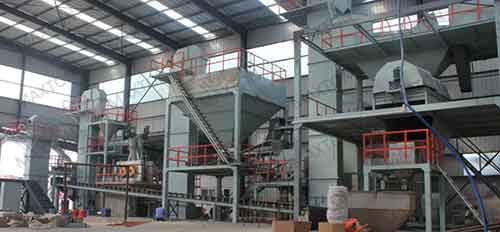
What else we can expect
The compacting granulation process is particularly suitable for processing heat-sensitive materials and does not have a strong requirement on the investment. Especially for material like ammonium bicarbonate, it has strong heat sensitivity and humidity sensitivity, avoids water and heat, is easy to absorb moisture and decompose, and its fertilizer efficiency is only 30%, so it is not suitable for other fertilizer granulation processes.
The main varieties that can be produced by the compacting granulation process include three types: ammonium sulphophosphate, ammonium nitrate phosphate and urea ammonium phosphate. The product variety and production scale can be adjusted at any time according to market supply and demand conditions.
With the further development of granular compound NPK fertilizers, the development direction of granulation technology is to increase the service life and production capacity of granulation equipment, extend the shelf life of granular compound fertilizer products, and reduce the loss of effective nutrients (mainly nitrogen) and energy consumption during the production process.
